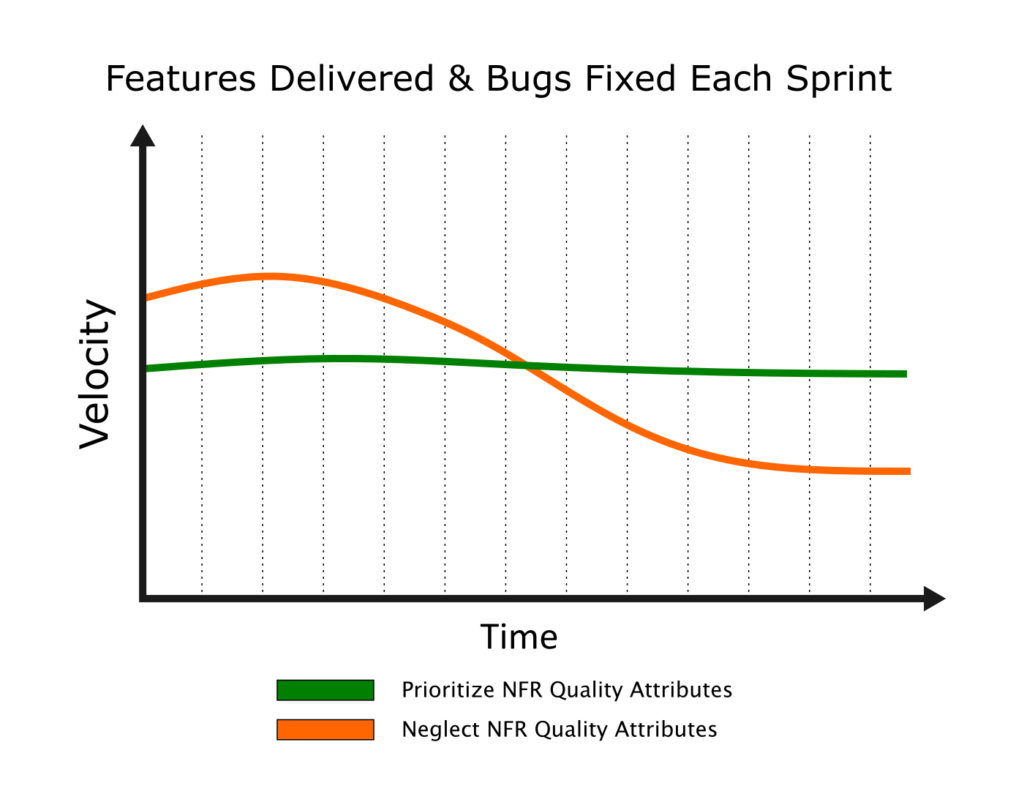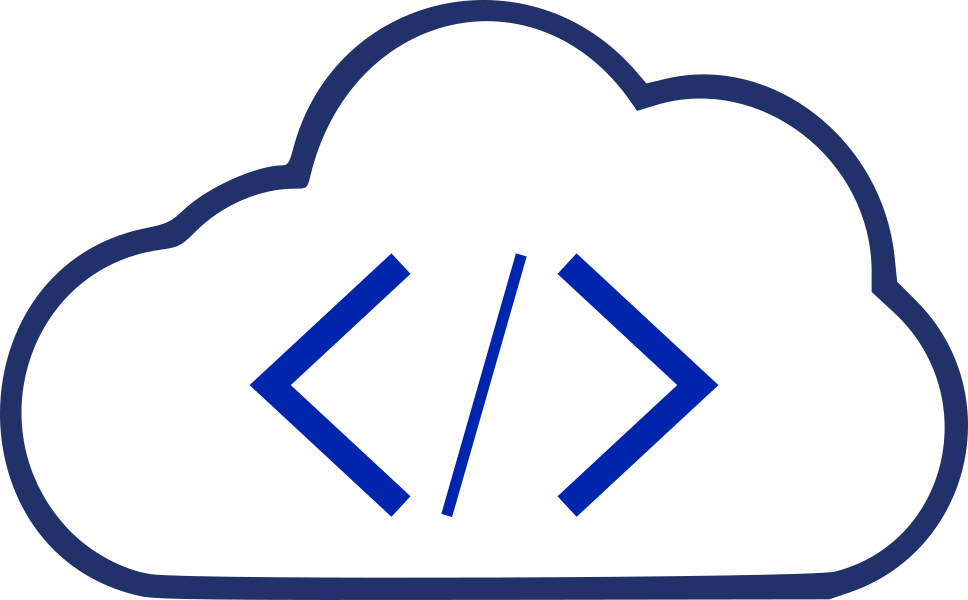The Benefits of Prioritizing Quality Attributes
In my previous post, I discussed the impact of Non-Functional Requirements (NFRs) on software engineering quality outcomes, introduced several commonly known and discussed NFRs, and addressed the importance of each one.
In this post, I delve into the dual impacts of NFRs: the positive outcomes of prioritizing these quality aspects and the significant negative consequences of neglecting them. I examine how focusing on NFRs enhances user experience, safeguards customer trust, and ensures software products’ long-term success and resilience.
Getting Lost in The Storm
When navigating a large looming backlog of features and bugs and an ever-increasing set of demands on your team and yourself, the quality details often get overlooked in favor of completing your immediate deliverables.
In such environments, non-functional requirements are secondary to delivering new features, fixing bugs, and supporting the existing system. While these tasks are undoubtedly important, a singular focus on meeting the bare minimum results in short-lived success.
Managed languages contribute to the problem and often offer too much aid to engineers, causing them to lose detailed focus on quality aspects of their work easily. These languages and platforms make certain tasks easier but can lead to inefficiencies if not used judiciously. Although these tools, platforms, and languages can provide robust and high-performance systems, the engineers are responsible for ensuring quality is not compromised and remains an unwavering priority throughout all aspects of development by utilizing the full suite of functionality available in the platform.
The simplicity and power of these high-level languages, such as C#, enable engineers to assemble elementary yet productive applications quickly. This ease of development significantly boosts productivity, allowing for rapid prototyping and swift deployment of functional features. However, this convenience often comes at a cost. Production applications quickly resemble a conglomeration of numerous proof-of-concept (POC) applications stitched together somewhat haphazardly. Instead of forming a cohesive, well-maintained, and highly integrated system, these applications suffer from fragmented architecture and inconsistent practices, resulting in a fragile, complex, time-consuming, and error-prone system.
The Impact of Neglecting Non-Functional Requirements
Neglecting non-functional requirements has severe consequences for both customers and engineering teams. When these quality aspects are overlooked, the software product faces several challenges that hinder its success and longevity.

Direct Customer Impact
From a customer’s perspective, a software product that fails to meet NFRs leads to a poor user experience. Issues such as slow performance, frequent crashes, security vulnerabilities, and new bugs frustrate users and drive them away from the product. In the competitive software market, retaining user trust and satisfaction is crucial, and neglecting NFRs results in a loss of customers and revenue.
Impact on Engineering Teams
For engineering teams, overlooking NFRs creates a myriad of challenges. Bug fixes, technology upgrades, and refactorings become more complex and time-consuming when the software is not designed to prioritize maintainability. Additionally, new features are hampered by underlying performance and scalability issues. As technical debt accumulates, development velocity slows down, making it harder for teams to keep up with deadlines and deliver high-quality software.
The frustration of being unable to focus on pioneering work and staying current with new technological advancements leads to a profound sense of dissatisfaction.
Skilled engineers thrive on the challenge of developing new features and innovations, pushing the boundaries of technology and creativity. However, their enthusiasm wanes when these talented professionals find themselves mired in the constant cycle of fixing bugs, supporting unstable systems, and dealing with the ramifications of neglected non-functional requirements. The frustration of being unable to focus on pioneering work and staying current with new technological advancements leads to a profound sense of dissatisfaction. Consequently, these engineers, yearning for an environment that values innovation and growth, are often compelled to seek opportunities elsewhere, losing invaluable expertise for their current teams.
The Positive Impact of Emphasizing Non-Functional Requirements
By prioritizing quality attributes like non-functional requirements, developers create software products that stand out and provide long-term benefits for users and engineering teams.

Enhanced User Experience
Users highly value a software product that performs well, scales effectively, and provides a secure and reliable experience. By focusing on NFRs, developers ensure that the software meets and exceeds user expectations, increasing user satisfaction and loyalty.
Streamlined Development and Maintenance
Emphasizing NFRs from the outset streamlines the development process and reduces the burden on engineering teams. A well-architected and maintainable codebase makes implementing bug fixes, technology upgrades, and new features easier. This, in turn, allows teams to maintain a respectable development velocity and avoid falling behind in technical debt.
A well-architected and maintainable codebase makes implementing bug fixes, technology upgrades, and new features easier.
Engineering Team Strength
Investing in quality software and emphasizing non-functional requirements has a profoundly positive impact on highly skilled engineers. When engineers work on well-architected systems prioritizing maintainability, performance, and scalability, their creativity and productivity flourish. They focus on producing new functionality and innovation rather than being bogged down by incessant bug fixes and system instability. This environment fosters a sense of accomplishment and keeps engineers engaged and motivated.
Moreover, engineers who are continually challenged and stay current with new technological advancements feel a sense of pride in their work. They are more likely to view their roles fulfilling and aligned with their career aspirations. This positive atmosphere not only retains existing talent but also attracts other highly skilled engineers who are eager to join a team that values innovation and growth.
Long-Term Success and Innovation
Investing in non-functional requirements sets the foundation for long-term success and innovation. As the software evolves and grows, it more effectively adapts to new challenges and opportunities. By prioritizing quality aspects, developers ensure that the software remains relevant and competitive.
Refactoring Always on the Radar
Refactoring should be considered an integral part of software development. Leaving refactoring opportunities until the code becomes unmanageable turns what should be a proactive improvement task into a cumbersome and challenging chore. As technology landscapes shift rapidly, code must be updated and refactored to keep pace. Regular refactoring makes code more maintainable and keeps cognitive and cyclomatic complexities low.
Refactoring is not just about fitting in new features or bug fixes; it’s about always considering the bigger picture even when applying minor changes to the code.
Adopting a Constant, Never Ending Improvement (CNEI) philosophy is essential. Refactoring is not just about fitting in new features or bug fixes; it’s about always considering the bigger picture even when applying minor changes to the code. This approach ensures code meets new demands and adapts to evolving technologies, updated business rules, changing assumptions, and new deployment models. By regularly refactoring, developers maintain clean, efficient, and scalable codebases ready to face future challenges. This proactive stance facilitates smoother transitions and adaptations, making the codebase robust and sustainable in the long run.
Identify Future Needs Early
Implementing changes and refactoring code as soon as possible for anticipated future functionality is crucial for maintaining a sustainable and adaptable codebase. When teams know that their code will eventually need to support multiple languages, for instance, removing hard-coded text, using text strings from multi-culture resource files, and integrating culture-sensitive string management at the earliest opportunity is imperative. This proactive approach ensures the code is ready to handle future requirements smoothly and efficiently.
Delaying these necessary changes leads to significant challenges and increased costs over time. As the codebase grows and becomes more complex, retrofitting it to accommodate new functionalities becomes daunting. Without implementing these changes early, the effort required to refactor and update the code later exponentially increases, consuming valuable time and resources. This also introduces new bugs and instabilities, further complicating development.
Therefore, it is essential to start integrating these changes early by refactoring any code that is being fixed or enhanced for other reasons, preparing it for upcoming changes. Additionally, all new code should be written immediately with these future needs in mind, ensuring it is robust and ready for adaptation. By adopting this forward-thinking approach, engineers maintain a clean and efficient codebase, reduce technical debt, and facilitate smoother transitions to new functionalities and requirements.
Velocity Feedback – Slow Down to Speed Up
The complete lifecycle of a software product is akin to a marathon rather than a sprint. Software products typically last for years and go through many evolutionary stages. Attempting to rush through development can lead to numerous long-term issues, and focusing on rapid delivery at the expense of thoroughness causes burnout, instability, and rapid productivity decline.
The value of slowing down just slightly to establish a greater focus on quality cannot be overstated. By addressing quality attributes such as non-functional requirements (NFRs), teams create a positive feedback loop that significantly enhances productivity and velocity in the long run. This approach aligns with the principles of the Circle of Influence, emphasizing the importance of controlling and optimizing what is within our immediate power to manage.

Every successful project has learned the impact of the point of diminishing returns. Essentially, rushing to “get things done” without a focus on doing them well, hits a critical juncture where going at the same pace isn’t possible anymore because of the self-imposed hurdles that have been put in place.
Diligent attention to quality attributes may initially require slightly more time, but this investment pays off many times over.
Diligent attention to quality attributes may initially require slightly more time, but this investment pays off many times over. By establishing a target velocity that prioritizes NFRs and encourages openness to refactoring, teams ensure their codebase remains robust, scalable, and maintainable. This proactive stance mitigates technical debt and fosters an environment where innovation and efficiency thrive.
The benefits of this approach extend to all stakeholders. Engineers experience greater job satisfaction and reduced burnout when working with stable, high-quality systems. Product managers and business leaders benefit from more predictable timelines and fewer unexpected disruptions. Users enjoy a superior experience with reliable, performant, and secure software.
In essence, slowing down to focus on quality establishes a consistent, reliable, and steady pace of productivity over the long haul. It creates a foundation for ongoing success and innovation, ensuring the software remains relevant and competitive in an ever-evolving technological landscape.
Enforce with Automation
Fully utilizing automated tools throughout the development process is imperative to ensure that quality and technical debt management principles are rigorously applied. Automated code analyzers should be integrated more comprehensively, enabling real-time identification of potential issues and adherence to coding standards. Compiler warnings should be addressed promptly and thoughtfully (e.g., locally disabled and commented when appropriate) or treated with the same severity as compiler errors or failing unit tests, preventing minor issues from escalating into significant problems.
Moreover, incorporating thorough code quality analyzers into the build pipeline is imperative. These tools, such as static analysis and linting, ensure that code quality is consistently evaluated and maintained. Builds that produce numerous warnings should not be ignored; they signal a lack of focus on quality and pose a risk to the project’s long-term success. By enforcing strict standards and addressing issues as they arise, teams can maintain a high level of code integrity and avoid the pitfalls of accumulating technical debt.
Track Technical Debt
Tracking individual technical debts is crucial for maintaining a healthy and sustainable codebase. Every shortcut taken, every performance issue, every bypassed refactoring opportunity, every instance where Clean Code principles are not applied, and every deprecated API should be meticulously documented. These technical debts must be treated with the same seriousness as new features or reported bugs. In an agile framework, it is essential to integrate these tasks into the backlog and address them in each sprint.
These technical debts must be treated with the same seriousness as new features or reported bugs.
This approach ensures that technical debt is visible and actionable rather than hidden behind a series of “TODO” comments in the code. By including technical debt items in backlog and velocity reports, teams gain a comprehensive view of the product’s state and the necessary work to be done. This transparency facilitates better planning, prioritization, and resource allocation.
Addressing technical debt consistently helps prevent the accumulation of issues that hamper the development process and degrade the quality of the software over time. It fosters a culture of continuous improvement and accountability, ensuring that the codebase remains clean, efficient, and adaptable to future requirements. Ultimately, tracking and addressing technical debts drives software systems to be more robust, scalable, and maintainable, meeting current and future demands.
Include Quality in Estimates and Sizing
Correctly accounting for quality attributes in your estimates and story sizing is vital for the overall success of a software project. Historically, the failure to allocate sufficient time for these attributes has led to them being deprioritized, detrimentally impacting the final product. When planning and estimating tasks, it is essential to consider performance, scalability, security, usability, and maintainability. This ensures the software meets its functional requirements and provides a superior user experience and long-term reliability.
By integrating quality considerations into your estimates, you acknowledge their importance and make them integral to the development process. This approach prevents the relegation of quality attributes to an afterthought, avoiding the common pitfalls of technical debt accumulation and the inevitable ‘firefighting’ that arises from neglecting these critical aspects. Acceptance criteria should explicitly address both the product’s functionality and quality, ensuring that the delivered software is robust and well-rounded.
Moreover, including quality attributes in your story sizing fosters a culture of meticulousness and accountability. It encourages teams to adopt best practices such as code reviews, testing, and refactoring, which are crucial for maintaining a clean and efficient codebase. This proactive stance enhances the product’s intrinsic quality and contributes to a more predictable and manageable development lifecycle.
Incorporating quality in estimates and sizing ultimately leads to a more sustainable and enjoyable development process. Teams experience fewer disruptions and surprises, leading to higher morale and job satisfaction. Stakeholders gain confidence in the software’s stability and performance, and users benefit from a seamless and reliable experience.
Call To Action
To effectively implement a focus on Non-Functional Requirements (NFRs) and quality attributes, engineers should adopt the following steps:
- Identify and Prioritize NFRs: Identify the NFRs relevant to your project, such as performance, scalability, security, usability, and maintainability. Engage stakeholders to prioritize these NFRs based on their impact on the software’s overall success.
- Utilize Automation to Enforce Quality: Leverage code analyzers during development and more extensively in build pipelines. Treat build warnings as errors and address them promptly.
- Integrate NFRs into Backlog and Planning: Ensure that NFRs are included in the product backlog alongside functional requirements. During sprint planning, allocate time and resources to address these NFRs, treating them equally as new features or bug fixes.
- Define Acceptance Criteria: Develop explicit acceptance criteria for each NFR, specifying the metrics and benchmarks that the software must meet. This clarity ensures that quality attributes are measurable and testable, facilitating their integration into the development process.
- Incorporate Quality in Estimates and Story Sizing: Consider the effort required to meet agreed-upon quality benchmarks for NFRs when estimating tasks and sizing user stories. This inclusion prevents the sidelining of quality attributes and promotes a culture of thoroughness and accountability.
- Implement Best Practices: Adopt best practices such as code reviews, automated testing, continuous integration, and refactoring to maintain a clean and efficient codebase. Require well-documented code, meaningful comments, and consistent naming conventions to enhance code quality and readability.
- Track and Address Technical Debt: Regularly track technical debt items, documenting any shortcuts, performance issues, or deprecated APIs. Integrate these items into the backlog and address them in each sprint to prevent their accumulation and ensure long-term code health.
- Monitor and Measure Quality Attributes: Continuously monitor and measure the software’s performance against the defined NFRs. Use tools and metrics to track progress and identify areas for improvement, ensuring that the software remains robust and reliable.
- Foster a Culture of Continuous Improvement: Promote a culture where quality is a shared responsibility among all team members and external stakeholders. Encourage open communication, knowledge sharing, and regular retrospectives to identify and implement improvements in the development process.
By following these steps, engineers ensure that NFRs and quality attributes are effectively integrated into the development lifecycle, resulting in a more sustainable, reliable, and high-quality software product.
Teams that perceive this as overly challenging, not worthwhile, or too labor-intensive have likely reached the transition point of decreasing productivity and stability and are already working in an environment of constantly playing catch-up or will soon be.
Teams that perceive this as overly challenging, not worthwhile, or too labor-intensive have likely reached the transition point of decreasing productivity and stability and are already working in an environment of constantly playing catch-up or will soon be. In such cases, it is essential to objectively assess the current situation and create a plan to address immediate issues, along with a roadmap to restore comprehensive product quality and processes. The first order of business is focusing on not falling further behind.
Summary
The post outlines a strategic approach to integrating Non-Functional Requirements (NFRs) into the software development lifecycle. Key steps include identifying and prioritizing NFRs with stakeholder involvement, incorporating them into the product backlog, defining explicit acceptance criteria, accounting for NFRs in estimates and story sizing, and implementing best practices such as code reviews and automated testing. Additionally, it emphasizes the importance of tracking and tackling technical debt, monitoring quality attributes, and fostering a culture of continuous improvement.
Sometimes, timelines necessitate temporarily prioritizing feature releases or urgent bug fixes over specific quality attributes. However, ensuring that compromising quality does not become a standard practice is crucial. When such compromises must be made, they should be documented, and plans should be made to promptly address and rectify these issues.
Focus on NFRs in a Cloud-First Mindset
A cloud-first mindset necessitates a strong emphasis on NFRs, as neglecting these requirements in cloud-native systems significantly increases operational costs and slows delivery cadence. However, the cloud-first mindset also applies to non-cloud-deployed systems because the impacts are the same, even if they are not as easily quantified.
If NFRs are not addressed, high operational costs stem from performance inefficiencies, scalability issues, and security vulnerabilities. Organizations prioritizing NFRs ensure more sustainable, reliable, and cost-effective operations, leading to faster and smoother delivery cycles.
References
Non-Functional Requirements: https://en.wikipedia.org/wiki/Non-functional_requirement
Circle of Influence: https://kzdev.net/software-engineering-circle-of-influence
Cloud First: https://kzdev.net/cloud-first
Clean Code: https://www.freecodecamp.org/news/how-to-write-clean-code
https://www.amazon.com/Clean-Code-Handbook-Software-Craftsmanship/dp/0132350882

